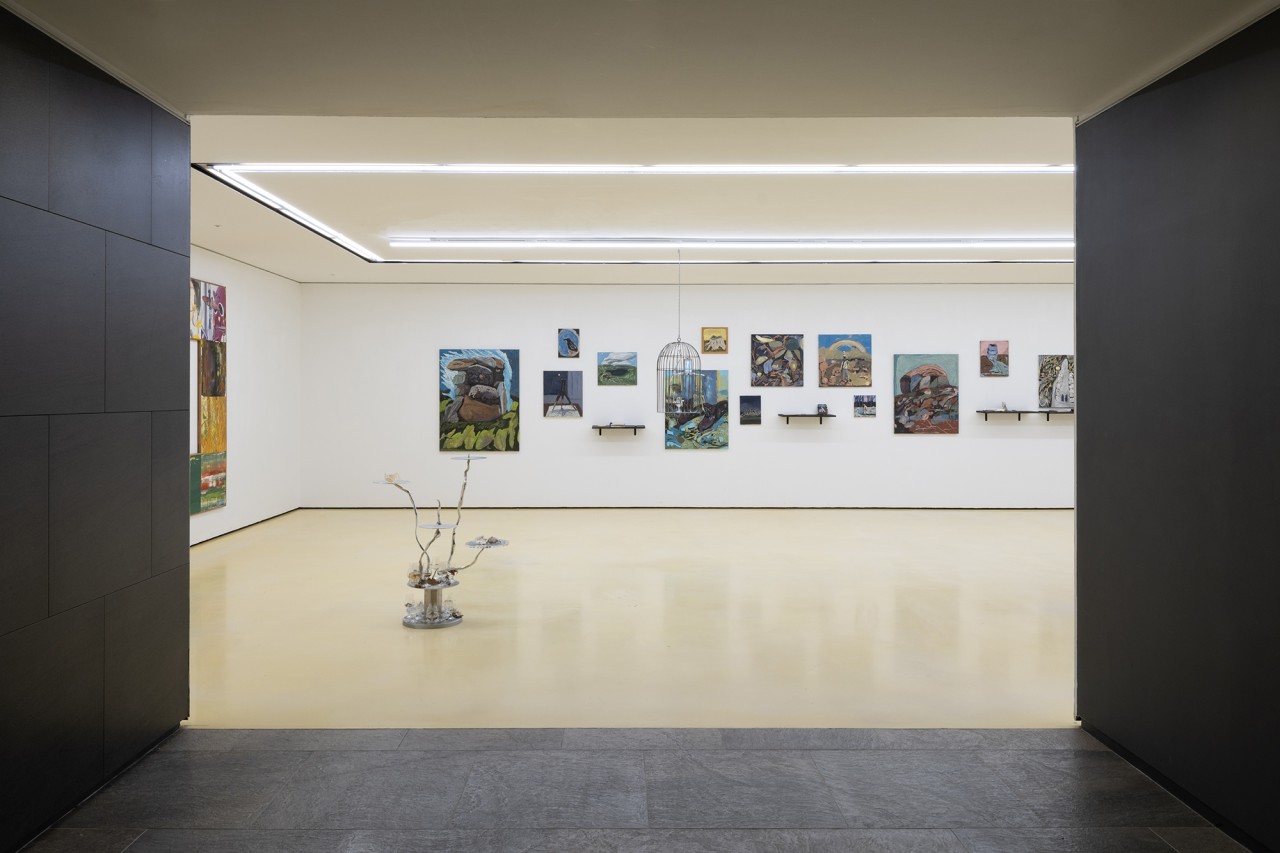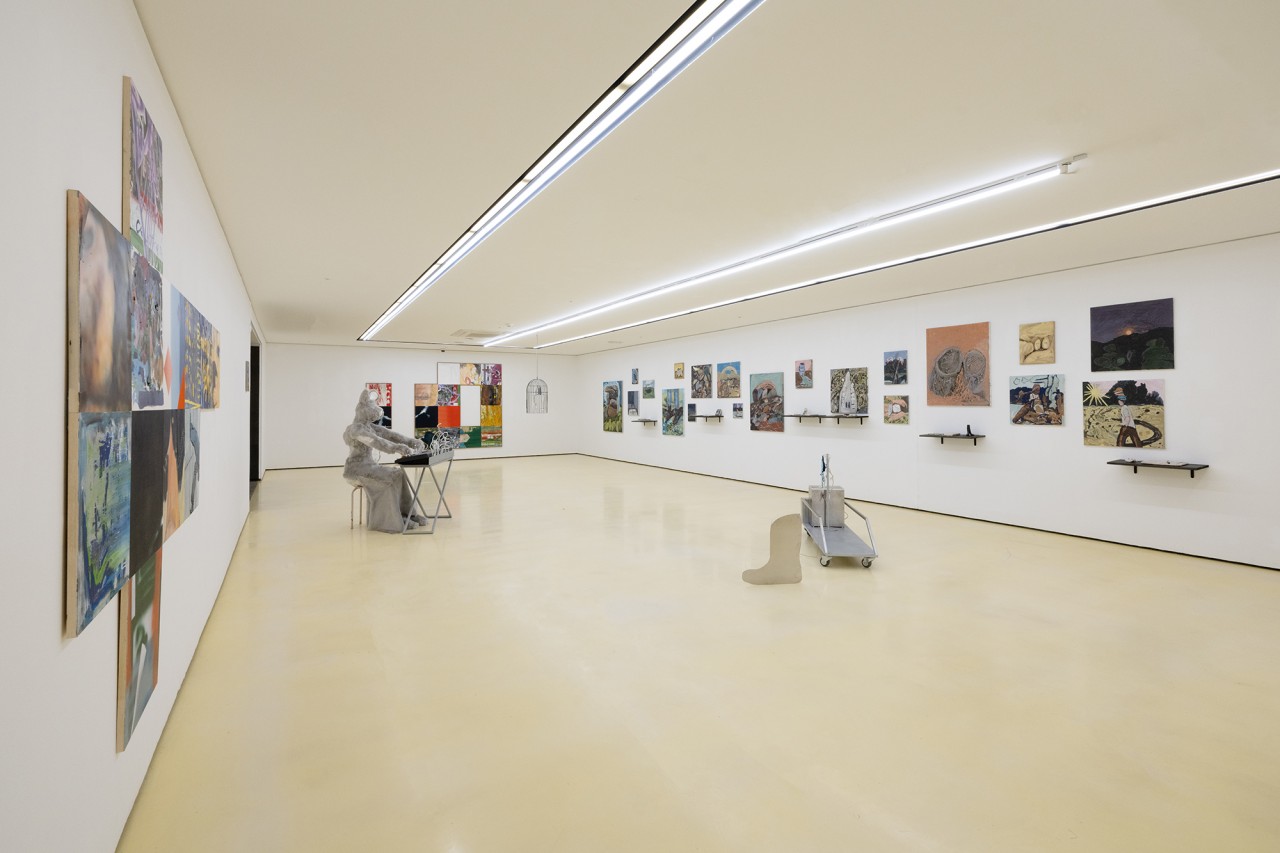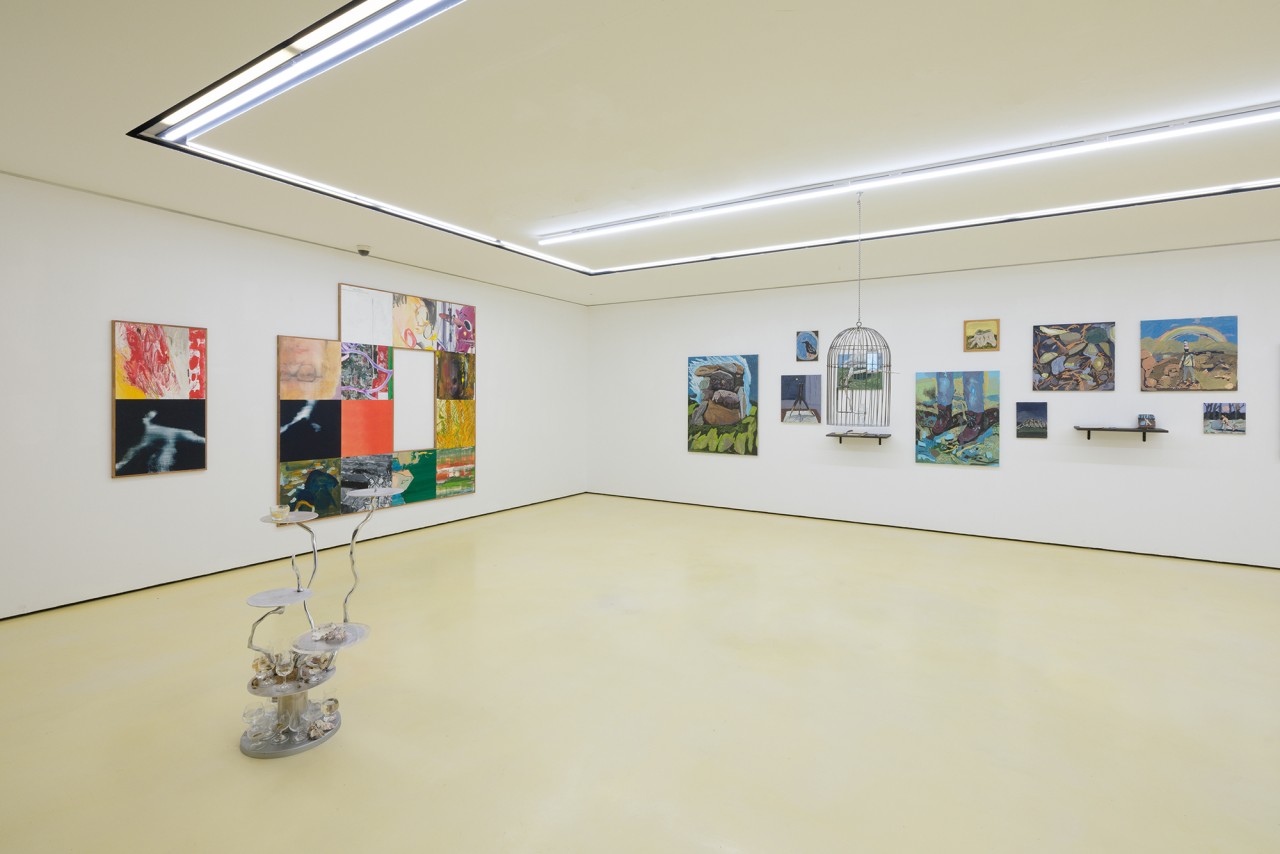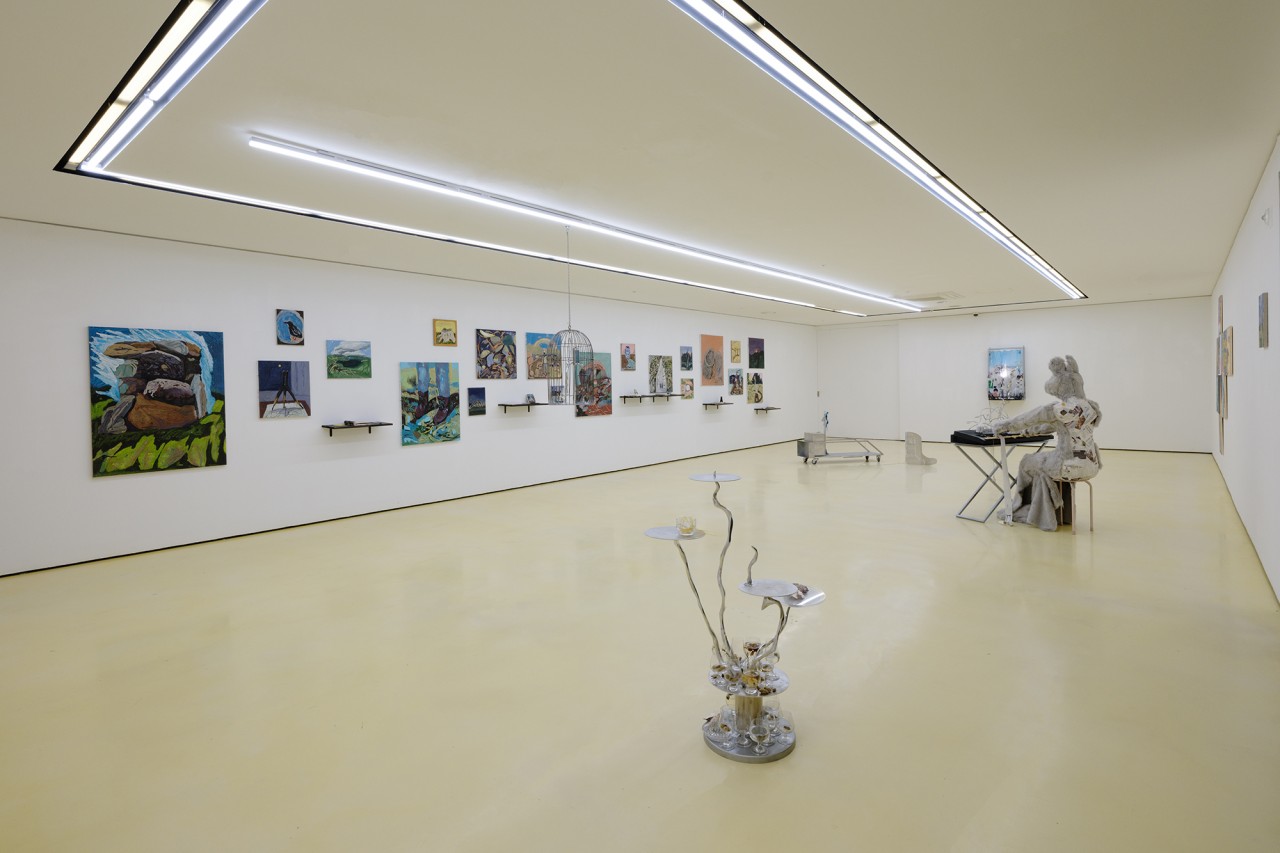Exhibitions
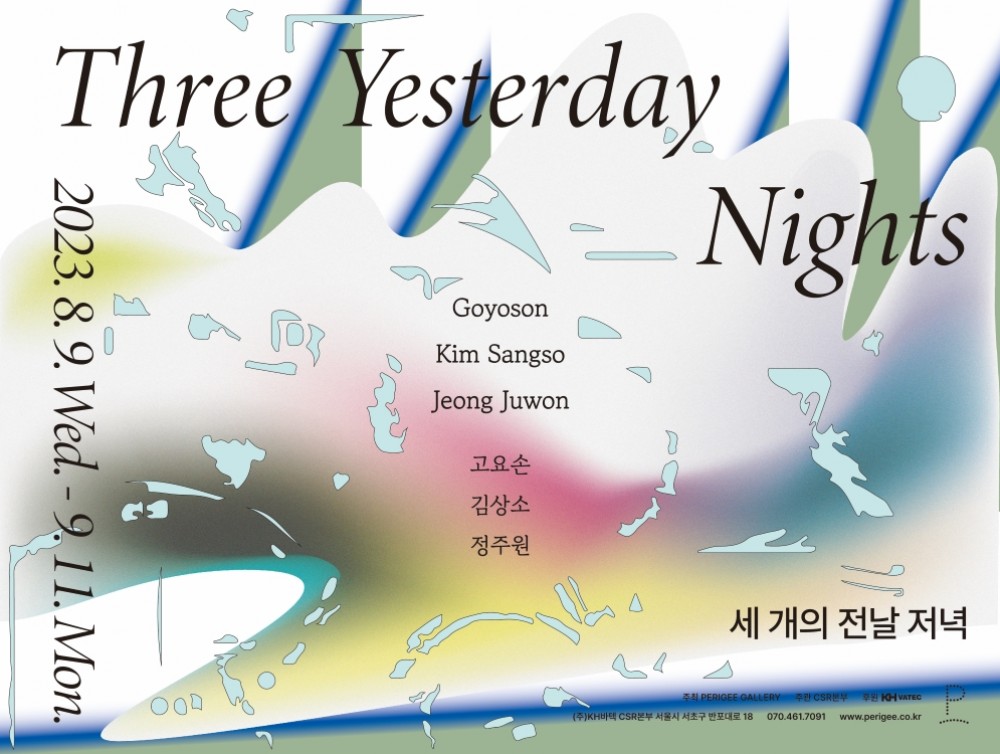
PERIGEE UNFOLD 2023
세 개의 전날 저녁
2023.08.09. WED ~
2023.09.11. MON
<세 개의 전날 저녁>
김명진(페리지갤러리 큐레이터)
《세 개의 전날 저녁》은 동시대 미술이 서사를 그려내는 방식에 주목하며 시작되었다. 과거의 미술 이론은 미술의 고유한 형식을 탐구하기 위해 내용이 되는 서사를 배제하는 식으로 둘 사이의 대립구도를 각인시켜 두었다. 그러나 이제는 오히려 형식과 내용이 서로 연동하는 방식을 규명해 나가는 것이 중요한 문제로 느껴지곤 한다. 이를테면 회화에 대한 논의는 더 이상 포괄적인 평면에 관한 탐구에만 그칠 수 없으며, 회화를 구성하는 내용들이 각자의 “내재하는 심층”을 지니고 있음을 인지한 상태에서 앞으로 나아갈 수 있게 될 것이다.¹
미술 작업들을 마주하며 ‘보기’를 넘어 ‘읽기’를 시도해본다고 하자. 미술은 이야기를 전달하기 위해 일반적이고 친절한 방식을 사용하지 않는다. 소설처럼 처음부터 끝까지 읽어나갈 수 있도록 순서를 제시하지도, 극예술처럼 사람이 직접 등장해 대사를 들려주지도 않는다. 내용의 심층을 담아내는 미술의 방식은 글에 비유하자면 산문보다는 고도로 응축된 시에 더 가까울 것이다. 각각의 작업들은 약속되지 않은 언어로 쓰인 시 같아서 쉽게 해독되지 않는다. 이는 관람자를 당황하게 하는 요인이자 특유의 매력으로 작용하는데, 미술을 ‘읽기’란 일종의 ‘쓰기’가 될 수도 있을 정도로 능동적인 행위가 된다. 그렇기에 단 하나의 정해진 결말은 미술이라는 매체와 어울리지 않는다.
이 전시 또한 하나의 메시지....
Three Yesterday Nights
Myungjin Kim (Curator of Perigee Gallery)
Three Yesterday Nights is an art exhibition that emerged from a contemplation of how contemporary art approaches narratives. Modern art theories have prioritized a compositional tension, often excluding narratives seen as mere external content in favor of exploring the intrinsic forms of art. However, in the present context, there is a growing importance in understanding the interplay between form and content. For instance, discussions on painting no longer remain confined to a comprehensive exploration of plane but rather advance by recognizing the unique “inherent depth” that each painting's content possesses.¹
Let's consider the notion of ‘reading’ an artwork, moving beyond mere ‘viewing.’ Art isn't bound to a singular, uniform method of conveying narratives. Unlike novels that follow a linear sequence or dramatic works with dialogues, art doesn't prescribe an order from start to finish. Instead, its methods for encapsulating profound layers of content might be likened more to the conciseness of a condensed verse rather than the e....
김명진(페리지갤러리 큐레이터)
《세 개의 전날 저녁》은 동시대 미술이 서사를 그려내는 방식에 주목하며 시작되었다. 과거의 미술 이론은 미술의 고유한 형식을 탐구하기 위해 내용이 되는 서사를 배제하는 식으로 둘 사이의 대립구도를 각인시켜 두었다. 그러나 이제는 오히려 형식과 내용이 서로 연동하는 방식을 규명해 나가는 것이 중요한 문제로 느껴지곤 한다. 이를테면 회화에 대한 논의는 더 이상 포괄적인 평면에 관한 탐구에만 그칠 수 없으며, 회화를 구성하는 내용들이 각자의 “내재하는 심층”을 지니고 있음을 인지한 상태에서 앞으로 나아갈 수 있게 될 것이다.¹
미술 작업들을 마주하며 ‘보기’를 넘어 ‘읽기’를 시도해본다고 하자. 미술은 이야기를 전달하기 위해 일반적이고 친절한 방식을 사용하지 않는다. 소설처럼 처음부터 끝까지 읽어나갈 수 있도록 순서를 제시하지도, 극예술처럼 사람이 직접 등장해 대사를 들려주지도 않는다. 내용의 심층을 담아내는 미술의 방식은 글에 비유하자면 산문보다는 고도로 응축된 시에 더 가까울 것이다. 각각의 작업들은 약속되지 않은 언어로 쓰인 시 같아서 쉽게 해독되지 않는다. 이는 관람자를 당황하게 하는 요인이자 특유의 매력으로 작용하는데, 미술을 ‘읽기’란 일종의 ‘쓰기’가 될 수도 있을 정도로 능동적인 행위가 된다. 그렇기에 단 하나의 정해진 결말은 미술이라는 매체와 어울리지 않는다.
이 전시 또한 하나의 메시지를 상정해두기보다는 느슨한 틀을 구축하며 시작한다. 전시의 제목은 호르헤 루이스 보르헤스의 『픽션들』에 등장하는 가상의 이야기 구조에서 착안한 것이다. 보르헤스가 제시한 가상의 소설 중에는 같은 장면에서 ‘세 개의 전날 저녁’으로 두 차례 갈라져 총 아홉 개의 소설로 이루어진 하나의 작품이 있다. ‘역행하고 그물눈처럼 갈라지는’ 이 아홉 개의 소설들은 동일한 하루에서 출발하지만 양립할 수 없는 다양한 성격의 전날 저녁들을 제시하고, 마침내 서로 만날 수 없는 여러 개의 갈림길들을 하나의 전체로 통합한다. 본 전시는 보르헤스를 참조하여 ‘쓰기로서의 읽기(혹은 읽기로서의 쓰기)’라는 문제의식과 ‘이야기의 여러 갈림길’이라는 구조를 가지고 고요손, 김상소, 정주원 세 사람의 작업을 함께 본다.
*
정주원의 작업은 주로 개인적인 서사에서 출발하지만, 그는 이야기를 ‘다 알려주지 않는’ 회화의 특성을 잘 인지하고 있기에 실제 서사와 이미지 사이의 간극을 다양한 해석 가능성으로 열어둔다. 그의 작업에서 읽히는 것은 매끄럽게 연결되는 서사라기보다는 일상 속에 일어난 낯선 균열을 드러내는 단상들이다. 이번 전시 작업들은 그가 여러 차례 몽골을 여행하며 본 것들과 만났던 사람들의 이야기를 다룬다. 도시인들에게 생경한 장소인 몽골은 일종의 환상적인 세계로 인식될 수 있지만, 반복되는 경험을 통해 일상으로 전환되는 순간부터는 더 이상 환상에 머물지 못한다. 과거의 기억으로 아름다운 추상이 되었던 그곳을 다시 현실로 마주하게 되는 순간에는 익숙함과 두려움이 교차한다. 계산적인 인간관계와 같은 예상치 못한 요인이 추억을 방해할 때나, 바닥에 널린 죽음의 흔적들을 시시때때로 마주하는 일이 아무렇지 않아질 때, 정주원이 보여주는 것은 바로 그러한 ‘다시 여행하기’의 순간에서 파생된 단상들이다. 회화 작업들과 더불어 도자로 구워진 편지지와 책들은 광활한 여행의 조각난 페이지들을 들춰볼 수 있게 하는 단서들로 자리한다.
김상소는 소설을 회화와 전시의 문법으로 ‘번역’하는 일에 관심을 두고 다양한 시도를 해오고 있다. 그가 이번 작업의 출발점으로 삼은 앤 카슨의 소설 『빨강의 자서전』은 ‘다시 쓴’ 신화이다. 그리스 신화에서 헤라클레스에게 죽임 당한 빨강 괴물 게리온에 관한 에피소드는 두 차례 다시 쓰였으며,² 비극의 서사를 지닌 주인공으로 전환된 게리온은 풍부한 이미지의 자서전을 보유하게 되었다. 김상소는 다시 쓰인 게리온과 헤라클레스의 다면적인 캐릭터성에 주목하여 그들의 면면을 분해하고 자기만의 방식으로 조합해 나간다. 각 캐릭터는 12~15개의 모듈을 조합한 형태로, 작가는 먼저 완성된 틀을 정해 두지 않고 부분들을 만들어내는 데 집중한 후에 몇몇 조각들을 취사선택하여 집합을 이루게 하는 방식을 택했다. 우리가 스스로의 면면조차 다 알지 못하듯 인물의 성격이란 때로는 해독 불가능하도록 모순적이기도, 사소하게 여겨졌던 것이 중요한 면을 이루기도 한다. 또한 결정적인 순간은 대개 지나간 후에 파악되곤 한다는 점에서, 현재의 순간순간은 아직 도래하지 않은 미래의 나를 형성하는 조각들이 된다. 많은 조각들 중 신중하게 선택된 이미지들이 게리온과 헤라클레스를 형성하고, 이렇게 만들어진 두 인물의 특징은 각각의 세부 내용뿐만 아니라 틀의 형태를 달리함으로써 드러난다.
고요손은 이번 전시에서 자신의 첫 개인전이었던 《미셸》(2021)에 대한 ‘다시 읽기(이자 다시 쓰기)’를 시도하여 일종의 속편이기도 한 신작을 선보인다. 그는 지금까지 조각을 바라보는 것 이외의 감각으로 활성화할 수 있는 다양하고 풍성한 방식을 실험해왔고, 그 일환으로 조각이 주인공이 되는 극을 만들어왔다. 《미셸》(2021)은 자신이 연출한 공간에서 여러 퍼포머(미셸)들로 하여금 조각들과 설치된 요소들을 작동시키도록 했으며, 이는 그야말로 하나의 미술 작업을 ‘읽는’ 다양한 가능성에 대한 실험이었다. 그리고 이제 다른 시공간에서 펼쳐질 <미셸2: 잉크와 사랑의 백업>(2023)을 만들면서 그는 작업을 독해하는 첫 번째 주체는 다름 아닌 작가 자신임을 상기한다. 이에 더해, 다른 두 작가의 작업 또한 소리와 몸짓으로 퍼포먼스에 융화시키며 공간 안에 새로운 서사를 불어 넣는 실험으로 이어진다. 같고도 다른 두 번의 극 안에서 등장인물들이 사진 찍고 드로잉하고 프린터를 작동시키는 등의 행위는 책으로 만들어지고, 이 흔적들은 다시 전시의 일부를 구성하게 된다.
세 작가들은 각자의 방식으로 이미 있었던 것(여행, 신화, 작품)을 다시 읽고, 다시 쓰며 새로운 전시를 만들어 나간다. 전시를 함께 만드는 과정에는 서로의 세계를 읽어보고 밀접하게 섞여보려 하는 시도도 포함되었다. 그 과정에서 ‘될 수 있었던 여러 개의 전시’가 있었는데, 이를테면 정주원은 가상의 몽골인 캐릭터를 구체적으로 설정해보려는 시도를 했었고, 김상소는 자신의 작품 중 하나를 움직일 수 있는 가벽처럼 두어 고요손의 퍼포먼스에서 작동하는 요소로 만들고자 했었다. 그러나 결과적으로 세 작가의 세계는 표면적으로는 연결되지 못했고, 이는 마치 보르헤스의 ‘세 개의 전날 저녁’이 양립할 수 없는 각자의 시간으로 흐르는 것과 같다. 그렇다 해도 준비 과정에서의 많은 대화는 어딘가 흔적을 남겼을 것이다. 각자의 ‘세 개의 전날 저녁’이 지나 동이 튼다면 이들은 한 번쯤 같은 시간을 공유하게 될지도 모를 일이다. 세 개의 갈림길을 온전히 따로 걷거나, 때때로 이면적인 연결을 발견하는 등 전시를 보는/읽는 방법(들)은 당신의 몫으로 남겨져 있다.
────────────
¹ 이 부분은 그레이엄 하먼의 논의를 참조하였다. 그는 “아방가르드 미술에서 내용의 임무는 모든 내용의 배후에 놓여 있는 보편적인 배경 매체를 암시하는 것이 더는 아니고 오히려 내용의 각 조각이 이미 독자적으로 전경과 배경 둘 다로 이루어져 있는 방식을 탐구하는 것”이라고 언급했다. (하먼, 『예술과 객체』, 250쪽.)
² 그리스 신화에서 헤라클레스의 12과업 중 열 번째 과제는 빨강 괴물 게리온을 죽이고 그의 소떼를 훔쳐 오는 것이었다. 이 에피소드를 게리온의 입장에서 다시 쓴 스테시코로스의 서정시를 동시대의 관점에서 다시 쓴 것이 앤 카슨의 소설이다.
Myungjin Kim (Curator of Perigee Gallery)
Three Yesterday Nights is an art exhibition that emerged from a contemplation of how contemporary art approaches narratives. Modern art theories have prioritized a compositional tension, often excluding narratives seen as mere external content in favor of exploring the intrinsic forms of art. However, in the present context, there is a growing importance in understanding the interplay between form and content. For instance, discussions on painting no longer remain confined to a comprehensive exploration of plane but rather advance by recognizing the unique “inherent depth” that each painting's content possesses.¹
Let's consider the notion of ‘reading’ an artwork, moving beyond mere ‘viewing.’ Art isn't bound to a singular, uniform method of conveying narratives. Unlike novels that follow a linear sequence or dramatic works with dialogues, art doesn't prescribe an order from start to finish. Instead, its methods for encapsulating profound layers of content might be likened more to the conciseness of a condensed verse rather than the expansiveness of an expository prose in writing. Each artwork isn't easily deciphered like a poem couched in an inaccessible language. This enigmatic quality both disconcerts viewers and exudes a magnetic allure. ‘Reading’ art evolves into an active endeavor, akin to a form of ‘writing’ in itself. Thus, a single conclusive interpretation doesn't fit the realm of art.
This exhibition also starts by adopting a loose framework rather than assuming a singular message. Its title was inspired by the structure of fictional narratives in Fictions by Jorge Luis Borges. Of the imaginary stories presented by Borges, there is a work made up of nine short stories that are divided into ‘three yesterday nights’ two times in the same scene. These nine tales radiate like a mesh from a common starting point (same day), but they unfold into diverse and incongruent yesterday nights experienced by distinct characters. Ultimately, they converge disparate crossroads into a unified whole. Referring to Borges, this exhibition examines the artworks of three artists—Goyoson, Sangso Kim, and Juwon Jeong—guided by the thought process of 'reading as writing' (or vice versa) and the structure of 'multiple crossroads in the story.'
Juwon Jeong’s work originates from her personal narratives. However, she deliberately maintains an openness to a multitude of interpretations stemming from the gap between narratives and images. This derives from her awareness of the intrinsic nature of painting, which inherently refrains from 'telling the whole story.' What’s read in her work are fragmentary thoughts that occur in everyday life rather than narratives that are seamlessly connected. Her paintings on display at this exhibition address the stories of the people she came across and the things she saw while traveling in Mongolia several times. Mongolia, a place unfamiliar to urban dwellers, can seem like a fantastic world, but it becomes familiar like everyday life through repeated experiences. Familiarity and fear intersect when a place has become a beautiful abstraction in our memories. For example, when unforeseen factors like interpersonal problems interfere with good memories from the past, or when it becomes a routine to see stark traces of death on the street, Jeong's work encapsulates experiences like this as fragmentary reflections stemming from the act of 'traveling again.' Ceramic letter paper and books along with her paintings serve as clues that allow us to look at the fragmentary pages of her vast journey.
Sangso Kim has been making various attempts to ‘translate’ novels into the visual language of paintings and exhibitions, capturing their essence and nuances within the realm of art. Anne Carson's novel Autobiography of Red influenced his work, embodying a concept of a 'rewritten myth.' In Greek mythology, the story of Heracles killing Geryon was rewritten two times,² and Geryon, who was transformed into a tragic hero, came to have an biography of rich images. Kim pays attention to the rewritten multifaceted characters of Geryon and Heracles, disassembles their aspects, and assembles them in his own distinctive way. Each character is a combination of 12 to 15 modules, so he chose to adopt several pieces to form a set after concentrating on creating parts without predetermining any complete frame. Just as we do not even know every aspect of ourselves, a person’s character is often indecipherably contradictory, and what’s considered trivial sometimes forms a significant facet. The present moments become the pieces that shape oneself in the future and decisive moments are usually only grasped after they have passed. Carefully selected images from a large number of pieces form Geryon and Heracles, while their characteristics are exposed by differing details and frames.
Goyoson makes an attempt to ‘reread’ his first solo show Michel (2021) in this exhibition, displaying his recent pieces that are thought of as sequels to his previous works. He has been experimenting with diverse and rich ways to tap into the senses other than the sense of sight to provide new ways of 'viewing' sculpture. As part of this practice, he has created a theater in which a sculpture becomes the main character. In Michel (2021), he had several performers called Michels operate sculptural and installation elements in the space. This work was truly an experiment allowing many possibilities for ‘rereading’ a work of art. Goyoson reminds himself that the first interpreter of his work is the artist himself. He realized this while creating Michel 2: Ink and Love Backup (2023). In addition, the work of the other two artists leads to an experimental result that brings a new narrative to the space by harmonizing his performance with sounds and gestures. The actions of the characters taking pictures, drawing, and operating the printer in the same yet different theater are made into a book, and these again form part of the exhibition.
These three artists create a new exhibition, rereading and rewriting already existing things (trips, myths, and artworks). The process of creating the exhibition together included an attempt to read each other's creative worlds and combine them closely. In the process, there were several exhibitions that could have been done. For example, Juwon Jeong tried to concretely realize an imaginary Mongolian character, while Sangso Kim wanted to make one of his works a movable wall that became an element working in Goyoson’s performance. However, the worlds of the three artists were not connected superficially, just like Borges’ ‘three yesterday nights’ flow into incompatible respective times. Even so, many conversations during the preparation process must have had an effect and influence on the artists. If the day breaks after each of their three yesterday nights, they might share the same time at least once. The way(s) of viewing/reading the exhibition, such as walking the three crossroads separately or discovering an inner connection, is left up to you.
────────────
¹ This refers to discussions raised by Graham Harman in “Art and Objects”.
² The tenth labor of Heracles in Greek mythology was to kill the red monster Geryon and obtain his cattle. Anne Carson's novel rewrote the lyric poem of Stesichorus from Geryon's point of view.



